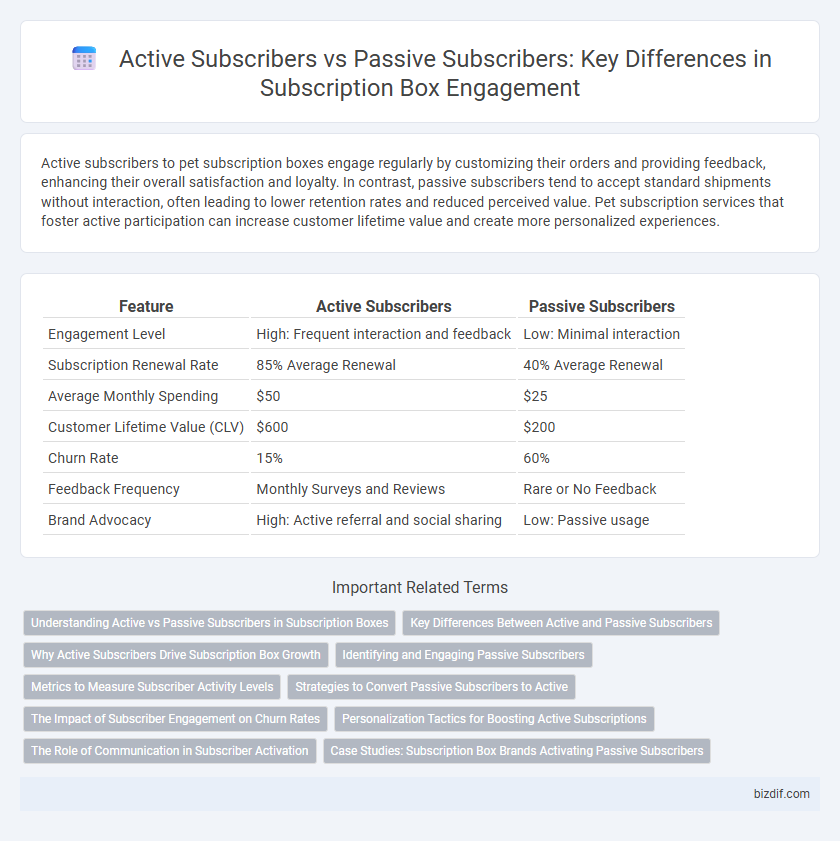Active subscribers to pet subscription boxes engage regularly by customizing their orders and providing feedback, enhancing their overall satisfaction and loyalty. In contrast, passive subscribers tend to accept standard shipments without interaction, often leading to lower retention rates and reduced perceived value. Pet subscription services that foster active participation can increase customer lifetime value and create more personalized experiences.
Table of Comparison
| Feature | Active Subscribers | Passive Subscribers |
|---|---|---|
| Engagement Level | High: Frequent interaction and feedback | Low: Minimal interaction |
| Subscription Renewal Rate | 85% Average Renewal | 40% Average Renewal |
| Average Monthly Spending | $50 | $25 |
| Customer Lifetime Value (CLV) | $600 | $200 |
| Churn Rate | 15% | 60% |
| Feedback Frequency | Monthly Surveys and Reviews | Rare or No Feedback |
| Brand Advocacy | High: Active referral and social sharing | Low: Passive usage |
Understanding Active vs Passive Subscribers in Subscription Boxes
Active subscribers frequently engage with subscription boxes by opening, reviewing, and utilizing their products, leading to higher retention rates and more valuable feedback for companies. Passive subscribers often receive boxes without interaction, increasing the risk of churn and reducing opportunities for brand loyalty growth. Identifying these behaviors enables subscription businesses to tailor marketing strategies and enhance customer experience, boosting overall subscription box success.
Key Differences Between Active and Passive Subscribers
Active subscribers consistently engage with the subscription box by regularly opening shipments and providing feedback, reflecting higher retention and satisfaction rates. Passive subscribers, on the other hand, often receive boxes without frequent interaction or renewal, posing challenges for long-term engagement and revenue predictability. Understanding these key differences helps businesses tailor marketing strategies to convert passive subscribers into active, loyal customers.
Why Active Subscribers Drive Subscription Box Growth
Active subscribers significantly boost subscription box growth by providing consistent revenue streams and valuable customer feedback that drive product improvements and personalized offerings. Their ongoing engagement increases brand loyalty and word-of-mouth referrals, expanding the subscriber base organically. Companies investing in strategies to convert passive subscribers into active participants enhance retention rates and overall lifetime customer value.
Identifying and Engaging Passive Subscribers
Passive subscribers often represent a critical opportunity for subscription box services to boost retention and revenue by reactivating dormant users. Identifying these subscribers involves analyzing engagement metrics such as infrequent logins, delayed payments, or low interaction with customization options. Targeted campaigns using personalized offers and feedback requests can effectively convert passive subscribers into active participants, enhancing overall subscription value.
Metrics to Measure Subscriber Activity Levels
Tracking subscriber activity levels involves analyzing metrics such as engagement rate, renewal frequency, and average order value to differentiate active subscribers from passive ones. Active subscribers typically exhibit higher engagement rates, consistent renewal patterns, and increased average spending per subscription cycle. Monitoring these key performance indicators helps businesses optimize retention strategies and predict revenue trends effectively.
Strategies to Convert Passive Subscribers to Active
Segmenting passive subscribers based on engagement metrics enables targeted campaigns that address specific interests and pain points, increasing conversion rates. Personalized offers, such as exclusive discounts or early access to products, stimulate activity by providing tangible value tailored to passive users. Leveraging automated email sequences combined with feedback loops helps identify barriers to engagement and refine strategies, transforming passive subscribers into active, loyal customers.
The Impact of Subscriber Engagement on Churn Rates
Active subscribers engage regularly with subscription box contents, leading to significantly lower churn rates compared to passive subscribers who seldom interact. Data shows that engagement activities such as unboxing videos, feedback submissions, and social media sharing enhance subscriber retention by fostering a sense of community and value. Subscription services leveraging personalized content and interactive experiences see a reduction in churn rates by up to 30%, highlighting the critical role of active participation in subscriber longevity.
Personalization Tactics for Boosting Active Subscriptions
Active subscribers engage regularly with personalized content, increasing retention rates by up to 40%, while passive subscribers often exhibit low interaction and higher churn risk. Employing targeted personalization tactics such as curated product selections based on purchase history and dynamic email campaigns can convert passive users into active subscribers. Leveraging behavioral data analytics to tailor offers and exclusive rewards enhances user experience and drives consistent subscriber activity.
The Role of Communication in Subscriber Activation
Active subscribers engage regularly with subscription box content, driven by targeted, personalized communication that fosters brand loyalty and increases retention rates. Passive subscribers exhibit low engagement, often requiring strategic outreach such as timely reminders, exclusive offers, and interactive campaigns to boost activation. Effective communication enhances subscriber value perception, transforming passive users into active customers and maximizing lifetime subscription revenue.
Case Studies: Subscription Box Brands Activating Passive Subscribers
Case studies reveal that subscription box brands increase active subscribers by implementing personalized re-engagement campaigns and exclusive offer incentives targeting passive subscribers. By analyzing user behavior data, brands can tailor communication and product recommendations to reactivate dormant accounts effectively. Brands like Birchbox and FabFitFun demonstrate significant subscription renewal rates through segmented email marketing and loyalty program integration.
active subscribers vs passive subscribers Infographic

 bizdif.com
bizdif.com